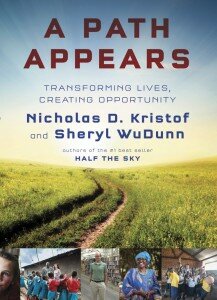 Nicholas Kristof and Sheryl WuDunn set out to investigate “how one can do a better job of making a difference, how one can help institute effective change” in their new book A Path Appears: Transforming Lives, Creating Opportunity. The husband-and-wife team traveled the world to view different approaches to accelerating progress against poverty.
Nicholas Kristof and Sheryl WuDunn set out to investigate “how one can do a better job of making a difference, how one can help institute effective change” in their new book A Path Appears: Transforming Lives, Creating Opportunity. The husband-and-wife team traveled the world to view different approaches to accelerating progress against poverty.
Reporting from rural West Virginia to the urban slums of Kenya, Kristof and WuDunn educate readers on challenges ranging from gang violence to sex trafficking to neglected tropical diseases (NTDs) like intestinal worms, trachoma and onchocerciasis. In an interview with National Public Radio about the book, Kristof highlighted NTDs as an example of an issue where incredible progress has been made – and where we have reason to hope even more can be done:
“I spent several decades covering these stories and, over that time, you really do see progress [being made]. I mean, when I first traveled around in Africa, for example, I was really struck by the blindness everywhere. River blindness, trachoma, so many middle-age people who were unproductive and could not help. In these days…people are not going blind anymore. So it sure feels to me as if there’s progress, but we just need to accelerate that.”
The result is a book that is equal parts a guide to domestic and international poverty, a thoughtful reflection on the nature of altruism and the state of modern charity, and a call to action for everyone to do what they can to make a difference – in short, a textbook of the “emerging science of how best to make a difference,” as they put it.
Kristof and WuDunn emphasize that everyone can make a tangible impact on the world’s poor, advising readers to evaluate charities carefully to choose organizations who can do the most with their dollars.
“What possible good could one measly donation do?” the authors ask rhetorically. Their answer: “The truth is that in recent years it has become clear that modest sums can help overcome disease and ease malnutrition…saving lives and attacking the cycle of poverty.”
Urging readers to join the movement for “effective altruism,” they highlight a number of charities who are exceptionally effective at fighting poverty – including a number of organizations focused on treating and preventing NTDs, including Helen Keller International, the Schistosomiasis Control Initiative, Deworm the World, and the Carter Center.
The authors are particularly keen to point out the impact of NTD treatment beyond its immediate health benefits:
“African schools tend to have high absenteeism, partly because kids are frequently sick, and deworming reduced rates of absenteeism by a quarter” in one study, they explain. Even more striking, researchers have found that “the cost of getting one more child into the school system for a year by deworming was $3.50…The next cheapest way was paying for school uniforms, which cost about $100 per extra child brought into the school system.”
Kristof and WuDunn remind readers that public health threats like NTDs “don’t just kill people, they also impose a kind of tax on everyone,” from reducing school attendance to sapping children of the energy they need to learn. Thus, treating NTDs is one example of an intervention proven to make an impact in breaking the cycle of poverty.
Taking a broader view of the “path to opportunity,” Kristof and WuDunn urge readers to couple their charitable giving with advocacy. “Not all problems can be solved by donations…We also need to hold governments – our own and others – accountable for doing their share,” they write.
We’re happy to see the authors urge people to get more involved. The END7 campaign pairs grassroots fundraising – 100% of which goes to NTD treatment programs to fill funding gaps – with grassroots advocacy aimed at raising the profile of NTDs on the global health and international development agenda.
Kristof and WuDunn conclude “This should be a remarkably hopeful time to be alive.”
“Crippling diseases like leprosy, guinea worm, and polio are on their way out…On our watch in the next few decades, we have a chance to eliminate the conditions – illiteracy, famine, parasitic disease, and the most abject poverty – that have shaped the majority of human existence.”
A Path Appears is an uplifting primer on innovative approaches to fighting poverty. We recommend it to anyone interested in learning how they can be more effective in their effort to make a difference — perfect for that hard-to-shop-for humanitarian on your holiday list!
The representatives on the END7 Student Advisory Board will also be reading the book over their winter break to prepare for a virtual book club meeting in January, the same month that a documentary series based on the book will premiere on PBS – a perfect kick-off to another semester of advocacy and fundraising to advance one poverty solution close to our hearts!
